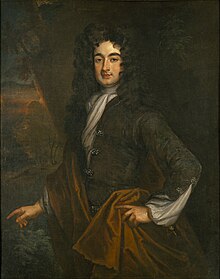William Byrd II | |
|---|---|
 | |
| Born | March 28, 1674 |
| Died | August 26, 1744 (aged 70) |
| Resting place | Westover Plantation |
| Education | Felsted School Middle Temple |
| Occupation(s) | Planter, lawyer, surveyor and writer |
| Known for | Founding Richmond, Virginia |
| Title | Colonel |
| Spouses |
|
| Children | 7, including William Byrd III |
| Father | William Byrd I |
William Byrd II (March 28, 1674 – August 26, 1744) was an American planter, lawyer, surveyor and writer. Born in the English colony of Virginia, Byrd was educated in London, where he practiced law. Upon his father's death, Byrd returned to Virginia in 1705. He served as a member of the Virginia Governor's Council from 1709 to 1744. Byrd was also the House of Burgesses's colonial agent in London during the 1720's. His life reflected aspects of both the British colonial gentry and an emerging American identity.[1]
Byrd led surveying expeditions of the border of Virginia and North Carolina. He is considered the founder of Richmond, Virginia.[1] Byrd expanded his plantation holdings and commanded county militias during his life. His enterprises included promoting Swiss settlement in mountainous southwest Virginia and iron mining ventures in Germanna and Fredericksburg.[1] A member of the Royal Society, Byrd was an early advocate of variolation to counter smallpox.[1]
He may be best known for his writings in his diary and the narratives of his surveying, some of which have been published in American literature textbooks.[1] Byrd recorded his exploits, which are notable for its openness on issues such as sex and Byrd's brutal treatment of his slaves.[2]
- ^ a b c d e Long, Thomas. "William Byrd (1674–1744)". Virginia Humanities, Encyclopedia Virginia. Retrieved October 17, 2021.
- ^ Malcolmson, Cristina (December 4, 2018). ""The Fairest Lady": Gender and Race in William Byrd's "Account of a Negro-Boy that is dappel'd in several Places of his Body with White Spots" (1697)". Journal for Early Modern Cultural Studies. 18 (1): 159–179. doi:10.1353/jem.2018.0006. ISSN 1553-3786. S2CID 166096874.